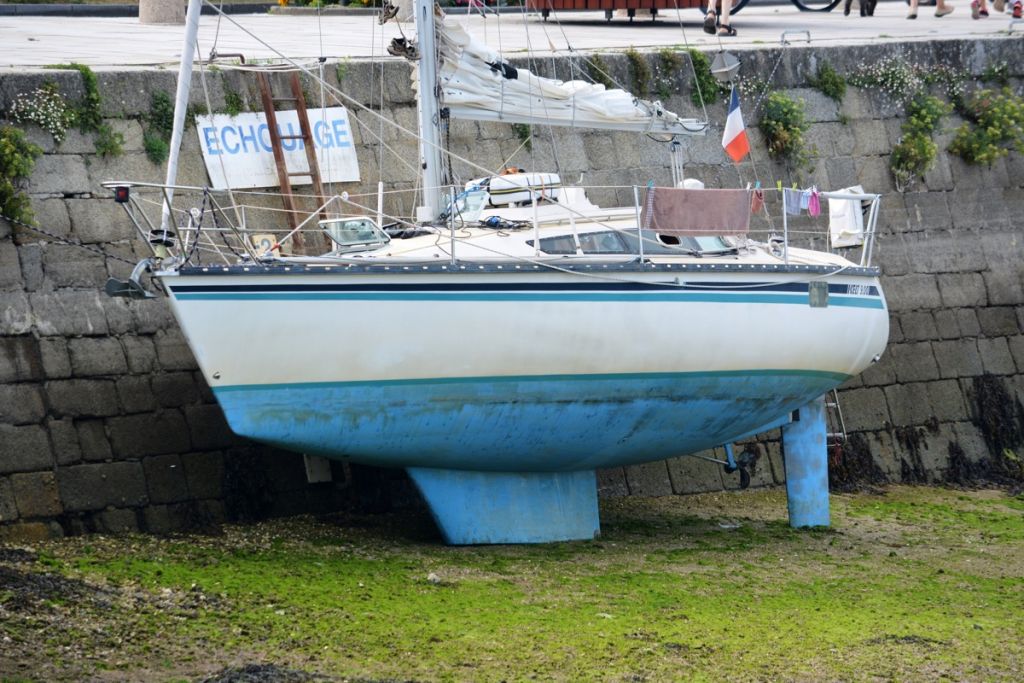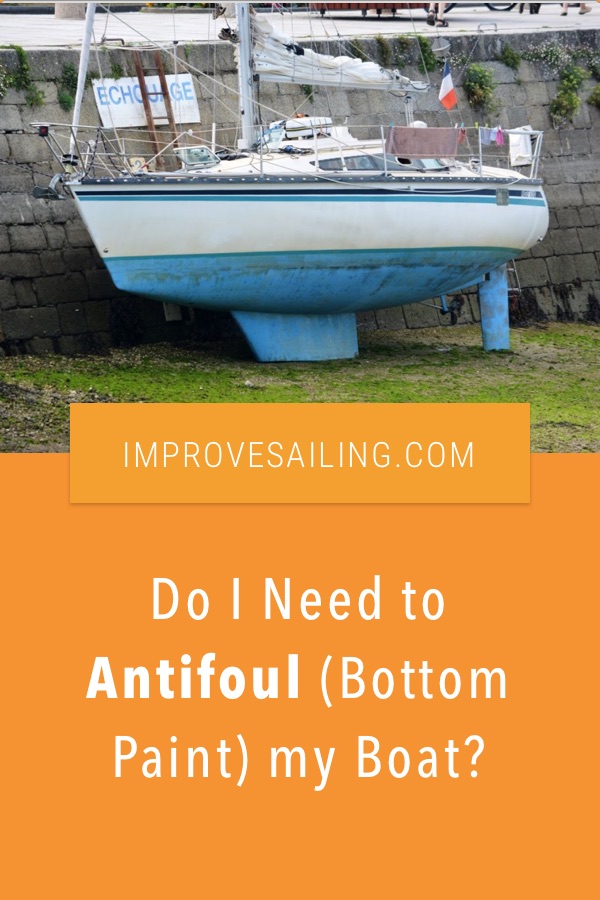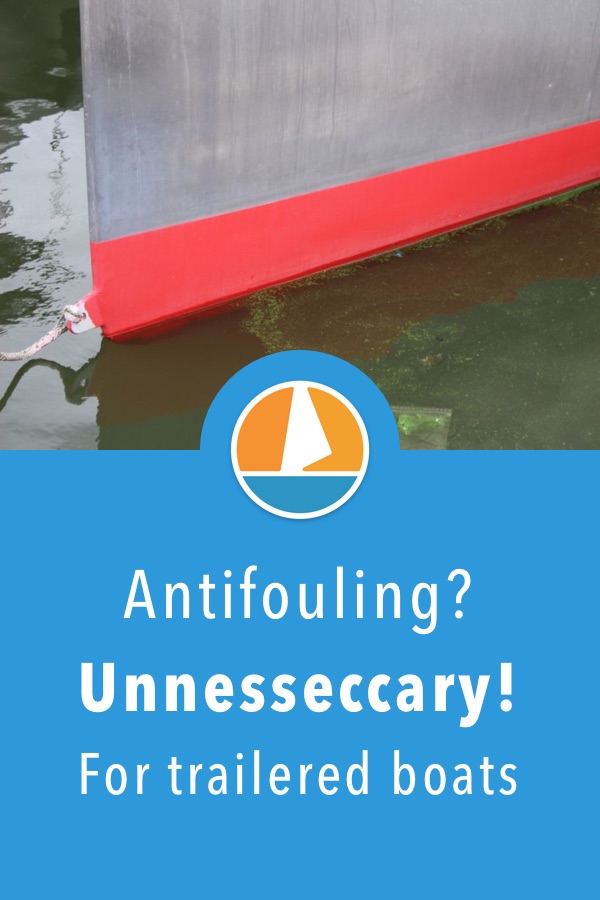Do I Need to Antifoul (Bottom Paint) my Boat? - Sometimes
Any time you buy a new boat, you get a work list as long as your arm. Bottom paint is expensive, toxic, and can be difficult to apply. It's an easy task to want to put off, but can you skip it?
Do I Need to Antifoul my Boat? You want to apply antifouling paint if you plan to store your boat in the water during the sailing season. If left in the water without protection, marine growth may attach to your boat's exposed hull. Marine growth slows a boat down and increases fuel consumption.
An unprotected boat left in seawater for a few weeks will acquire a coat of slime and algae. By the end of the summer it may have large weeds and hard growth such as barnacles and oysters that may require power washing, sanding or even chemical treatment to remove it all. Freshwater sailors have a few more options and may be able to get away without paint, but it's a wise precaution.
Antifouling can be a daunting project with a lot of options, but knowing how and where you plan to use your boat will help you pick a good solution and keep your boat sailing fast. So let's find out what you need to know.

Antifouling Needs for Different Conditions
Here are the antifouling needs for the most common sailing, storage and use conditions:
- Salt water, in-water storage - Antifoul your boat well. You may need annual application.
- Fresh water, in-water storage - Most locales you will need antifouling.
- Dry sailing (Fresh or salt) - There's no need to antifoul
- Full-time cruiser - A multi-season paint is a must.
- Racer - Serious racers will antifoul with a hard paint that can be buffed and burnished to a slick finish.
Dry sailing simply means that you store your boat out of the water in between trips.
Of course, there's more to it - I'll discuss the different factors in detail below.
How Will You Use Your Boat?
Are you a cruiser? Do you plan to race in serious events? Or maybe just the local beer can races? Where in the world do you store and use your boat?
How you use your boat impacts the choices you will make for bottom paint, how long an antifouling lasts, and how much care and maintenance your bottom will require.
Geography
A sailor in Australia - a place with no winter and no lay up season - has very different requirements from a sailor in Maine, a great lakes racer in Michigan, or a full-time blue water cruiser.
The Australian boat is rarely out of the water and needs full-time protection, while the boat in Maine has a short season and a long layup. So a multi-season co-polymer may suit the Australian boat better than a single season ablative which works well for the Down East boat that gets hauled every fall.
The racer on Lake Superior may need a more mild paint with special requirements for freshwater. The blue water cruiser wants an aggressive but long lasting ablative that will provide multiple years of coverage with little maintenance beyond the occasional scrub, since haul outs to repaint aren't always easy to schedule.
Racer or a Cruiser?
For a competitive racer performance is almost everything. They will choose a hard paint that is wet-sanded to a silky smooth finish, and they'll put up with diving on the boat before races or paying someone to do it to maintain that performance edge. A casual Wednesday night club racer may not be willing to make the same effort as someone taking their boat to regional or national events.
Your typical weekend cruiser? They want to paint the boat in the spring, launch the boat, and not give a thought to the bottom until the boat comes out of the water in the fall. Depending on how warm the water is, maybe they'll look under it mid season to make sure nothing big has grown, but it's not a maintenance priority. Soft or co-polymer ablatives suit most cruisers.
Dry Sailing
The easiest way to avoid dealing with bottom paint is to dry sail your boat. Dry sailing means you store your boat out of the water.
If you store your boat out of the water and only put it in while using it, antifouling should not be necessary.
Most small sailing dinghies are dry sailed and need not be painted. Some racers dry sail larger boats, and many marinas and yacht clubs have cranes than can launch boats up to a few thousand pounds, and ramps where you can launch from a trailer. Depending on where you keep your boat, you may have to pay for this every time you haul out and launch.
The main advantages to dry sailing your boat are ease of maintenance, always having a clean, fast bottom, and keeping your boat away from longer term exposure to the water. The extra time and expenses you may occur to launch and haul the boat every time may offset this.
Some boat owners paint dry sailed boats anyway, to avoid any marine buildup if they leave the boat in for a few days and to provide some protection from direct contact with seawater.
Fresh Water
Not all fresh water mooring areas have the intense and rapid growth you find in sea water, so it may be possible to store your boat in water without antifouling for seasonal sailing. Take care to check and clean the bottom through the season, and plan for a pressure washing at season's end to remove any buildup.
The best way to avoid problems is to ask other boat owners in the area what they use for bottom paint. If the body of freshwater isn't in an area with growth risk, sailors in the area will know if it's safe sail without antifouling for the season.
Talking to long-time sailors about where you keep your boat is a good way to find out what problems you may expect, and steps you can take to avoid them. This doesn't apply just to bottom paint, but to everything from stray galvanic corrosion to keeping birds and marine mammals from making a mess of your boat.
How Antifouling Works
Antifouling paint contains chemicals toxic to marine growth and inhibit it from attaching to the hull. The specific agent can vary, but copper is a common element of many bottom paints, though copper free paints are becoming more common. Whether soft ablative paint, a harder multi-season copolymer, or a hard paint it will contain some chemical to repel growth. The differences lie in how the paint is released, and what happens to the paint.
It's regulated, of course
The toxic nature of bottom paint has led to regulations about its application and removal, and the bottom paints allowed in your area. Many marinas have strict rules in place about where you can sand your bottom or paint your boat to comply with local ordinances or good environmental practices.
In most cases it's difficult to buy an illegal antifouling in the area it will be used, as it will not be on the shelves in local chandleries. Be careful when ordering paint on-line, or painting your boat before moving it to a new location.
Types of Antifouling
Antifouling comes in a bewildering array of options from several major providers. The common element is they are all expensive, though some are much more reasonable than others. Choosing the wrong paint can be an expensive mistake if it doesn't provide the protection you need.
Ablative
Most cruisers prefer "ablative" paint. This paint is softer and wears off, releasing antifouling compounds at a controlled rate over time. It can be more effective than other types of paint while releasing fewer toxic elements into the water. They work best when a boat is moved more frequently.
Some ablative paints may lose effectiveness when exposed to air for a long time and are often single-season paints where boats layup over the winter. Others include co-polymer or hybrid ingredients to form a harder finish which doesn't lose effectiveness when left out of the water and are better for multi-season applications.
Because ablative paints melt away over time, sanding them before repainting is easier.
Examples of ablative bottom paint:
- Interlux Micron ACT
- Pettit Hydrocoat
- Seahawk BioCop TF
Hard Paints
A hard paint leaches the protective biocides out over time but the paint does not slough off. These paints form a barrier hard enough to sand to a smooth finish for better sailing speed, and are popular with racers because of the substantial performance increase. The paints are often based on Teflon or epoxy to get the hard finish.
The downside to these paints is they are not as effective as ablatives, and the paint stays on the boat and requires more aggressive sanding. They require more maintenance to keep the bottom clean.
While they are far more effective than a bare hull, a hard bottom paint will still accumulate slime and buildup more than ablatives. Competitive racers clean their polished bottoms to remove slime that can build up in as little as a week, though it takes longer for hard growth to appear. This is not an effort or expense most weekend cruisers will want.
Some hard bottom paints include:
- Interlux VC Offshore
- Petit Trinidad
- Seahawk Sharkskin
Consider paint compatibility when choosing a brand and ask the prior owner what’s on the boat if you have a new-to-you boat to protect. Not all paints are compatible, and incompatible paints will not stick well.
Most companies provide charts to show which paints you can apply over their other products. You can apply many paints from the same manufacturer over each other with minimal preparation.
For example, you can apply Micron ACT over Micron CSC with a simple surface cleaning, but putting ACT over Micron 66 requires a thorough sanding and priming for the paint to stick.
If you change to a different type or brand of bottom paint, you must check compatibility or remove all the old paint.
Did you find the answer to your specific question?
👍 7 👎 0


Leave a comment